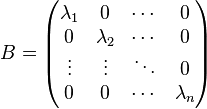Real Quadratic Forms
See also: Sylvester's law of inertia and Definite formAny n×n real symmetric matrix A determines a quadratic form qA in n variables by the formula
Conversely, given a quadratic form in n variables, its coefficients can be arranged into an n×n symmetric matrix. One of the most important questions in the theory of quadratic forms is how much can one simplify a quadratic form q by a homogeneous linear change of variables. A fundamental theorem due to Jacobi asserts that q can be brought to a diagonal form
so that the corresponding symmetric matrix is diagonal, and this is even possible to accomplish with a change of variables given by an orthogonal matrix – in this case the coefficients λ1, λ2, …, λn are in fact determined uniquely up to a permutation. If the change of variables is given by an invertible matrix, not necessarily orthogonal, then the coefficients λi can be made to be 0,1, and −1. Sylvester's law of inertia states that the numbers of 1 and −1 are invariants of the quadratic form, in the sense that any other diagonalization will contain the same number of each. The signature of the quadratic form is the triple (n0, n+, n−) where n0 is the number 0s and n± is the number of ±1s. Sylvester's law of inertia shows that this is a well-defined quantity attached to the quadratic form. The case when all λi have the same sign is especially important: in this case the quadratic form is called positive definite (all 1) or negative definite (all −1); if none of the terms are 0 then the form is called nondegenerate; this includes positive definite, negative definite, and indefinite (a mix of 1 and −1); equivalently, a nondegenerate quadratic form is one whose associated symmetric form is a nondegenerate bilinear form. A real vector space with an indefinite nondegenerate quadratic form of index (p,q) (p 1s, q −1s) is often denoted as Rp,q particularly in the physical theory of space-time.
The discriminant of a quadratic form, concretely the class of the determinant of a representing matrix in K/(K*)2 (up to non-zero squares) can also be defined, and for a real quadratic form is a cruder invariant than signature, taking values of only “positive, zero, or negative”. Zero corresponds to degenerate, while for a non-degenerate form it is the parity of the number of negative coefficients,
These results are reformulated in a different way below.
Let q be a quadratic form defined on an n-dimensional real vector space. Let A be the matrix of the quadratic form q in a given basis. This means that A is a symmetric n×n matrix such that
where x is the column vector of coordinates of v in the chosen basis. Under a change of basis, the column x is multiplied on the left by an n×n invertible matrix S, and the symmetric square matrix A is transformed into another symmetric square matrix B of the same size according to the formula
Any symmetric matrix A can be transformed into a diagonal matrix
by a suitable choice of an orthogonal matrix S, and the diagonal entries of B are uniquely determined — this is Jacobi's theorem. If S is allowed to be any invertible matrix then B can be made to have only 0,1, and −1 on the diagonal, and the number of the entries of each type (n0 for 0, n+ for 1, and n− for −1) depends only on A. This is one of the formulations of Sylvester's law of inertia and the numbers n+ and n− are called the positive and negative indices of inertia. Although their definition involved a choice of basis and consideration of the corresponding real symmetric matrix A, Sylvester's law of inertia means that they are invariants of the quadratic form q.
The quadratic form q is positive definite (resp., negative definite) if q(v) > 0 (resp., q(v) < 0) for every nonzero vector v. When q(v) assumes both positive and negative values, q is an indefinite quadratic form. The theorems of Jacobi and Sylvester show that any positive definite quadratic form in n variables can be brought to the sum of n squares by a suitable invertible linear transformation: geometrically, there is only one positive definite real quadratic form of every dimension. Its isometry group is a compact orthogonal group O(n). This stands in contrast with the case of indefinite forms, when the corresponding group, the indefinite orthogonal group O(p, q), is non-compact. Further, the isometry groups of Q and −Q are the same (O(p, q) ≈ O(q, p)), but the associated Clifford algebras (and hence Pin groups) are different.
Read more about this topic: Quadratic Form
Famous quotes containing the words real and/or forms:
“Between ourselves and our real natures we interpose that wax figure of idealizations and selections which we call our character.”
—Walter Lippmann (1889–1974)
“Year chases year, decay pursues decay,
Still drops some joy from with’ring life away;
New forms arise, and diff’rent views engage,”
—Samuel Johnson (1709–1784)
